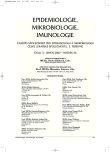-
Medical journals
- Career
Immunogenicity of Vaccines Against Viral Hepatitis A and B in the Population above 40 Years of Age – Impact of Risk Factors
Authors: R. Chlíbek 1; J. Smetana 1; R. Šindelář 1; B. Čečetková 2; R. Prymula 1; I. Kohl 3
Authors‘ workplace: Fakulta vojenského zdravotnictví UO, Hradec Králové 1; Thomayerova všeobecná fakultní nemocnice, Praha 2; GlaxoSmithKline, Praha 3
Published in: Epidemiol. Mikrobiol. Imunol. 56, 2007, č. 3, s. 119-128
Overview
The immune reaction following vaccination against viral hepatitis A (HAV) and viral hepatitis B (HBV) can be influenced by a variety of factors. Among the most important are age, gender and body weight.
Study objective:
This prospective randomized study compared immunogenicity of available vaccines against HAV and HBV infections in the population above 40 years of age and the impact of risk factors.Material and Methods:
The vaccinated subjects were divided into 3 groups based on the vaccine used. Within each group, the subjects were equally distributed by age, gender and body weight. The vaccine was always applied intramuscularly in the deltoid. Group 1 was given the combined vaccine TwinrixTM (GSK) against HAV and HBV infections in the left deltoid; group 2 was vaccinated with the HavrixTM vaccine against HAV (GSK) in the right deltoid and with the Engerix-BTM vaccine against HBV (GSK) in the left deltoid; group 3 received the VaqtaTM vaccine against HAV (Sanofi Pasteur) in the right deltoid and the HB VAX PROTM against HBV (Sanofi - Pasteur) in the left deltoid.Results:
The following anti-HBs seroprotectivity rates: 92 %, 80 % and 71 %, and anti-HAV seropositivity rates: 97 %, 99 % and 99 %, were observed at 1 month after the end of the complete vaccination in groups 1, 2 and 3, respectively. The anti-HBs seroprotectivity rate was statistically significantly higher in group 1. The anti-HAV seropositivity rates were comparable (did not significantly differ) in all three study groups.Conclusion:
The impact of age was revealed: the immune response decreases with increasing age. The lowest immunogenicity of the vaccines against HAV and HBV infections was observed in subjects above 60 years of age. Males achieved lower geometric mean titres (GMT) of antibodies and lower seroprotectivity rates compared to females. The impact of body weight was also observed, with the obese subjects showing the lowest immune response. The anti-HBs reactivity was significantly influenced by the vaccine used. The combined vaccine against HAV and HBV infections (TwinrixTM) induced higher anti-HBs seroprotectivity and comparable anti-HAV seropositivity when compared with the other monovalent study vaccines in the population above 40 years of age.Key words:
vaccine against HAV and HBV infections – imunogenicity – anti-HBs – anti-HAV – gender – BMI.
Labels
Hygiene and epidemiology Medical virology Clinical microbiology
Article was published inEpidemiology, Microbiology, Immunology

2007 Issue 3-
All articles in this issue
- Clinically Important β-Lactamases of Gram-Negative Bacteria: Extended-Spectrum β-Lactamases (ESBL)
- Prion Diseases
- Immunogenicity of Vaccines Against Viral Hepatitis A and B in the Population above 40 Years of Age – Impact of Risk Factors
- ABC Transporter Proteins in Multidrug Resistance of Microorganisms
- Results of Surveillance of Human Leptospirosis
- Epidemiology, Microbiology, Immunology
- Journal archive
- Current issue
- Online only
- About the journal
Most read in this issue- Clinically Important β-Lactamases of Gram-Negative Bacteria: Extended-Spectrum β-Lactamases (ESBL)
- Prion Diseases
- Immunogenicity of Vaccines Against Viral Hepatitis A and B in the Population above 40 Years of Age – Impact of Risk Factors
- ABC Transporter Proteins in Multidrug Resistance of Microorganisms
Login#ADS_BOTTOM_SCRIPTS#Forgotten passwordEnter the email address that you registered with. We will send you instructions on how to set a new password.
- Career

